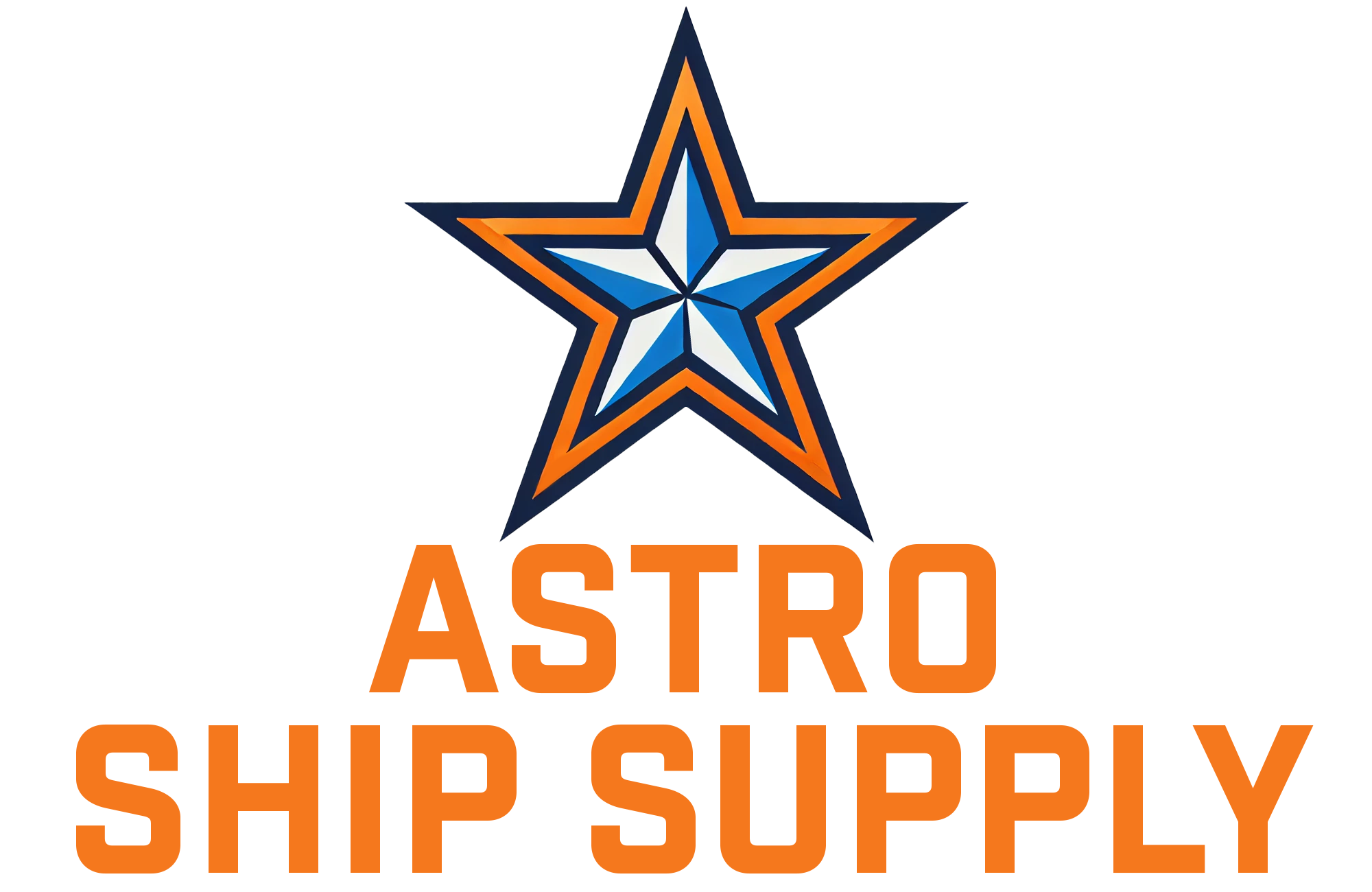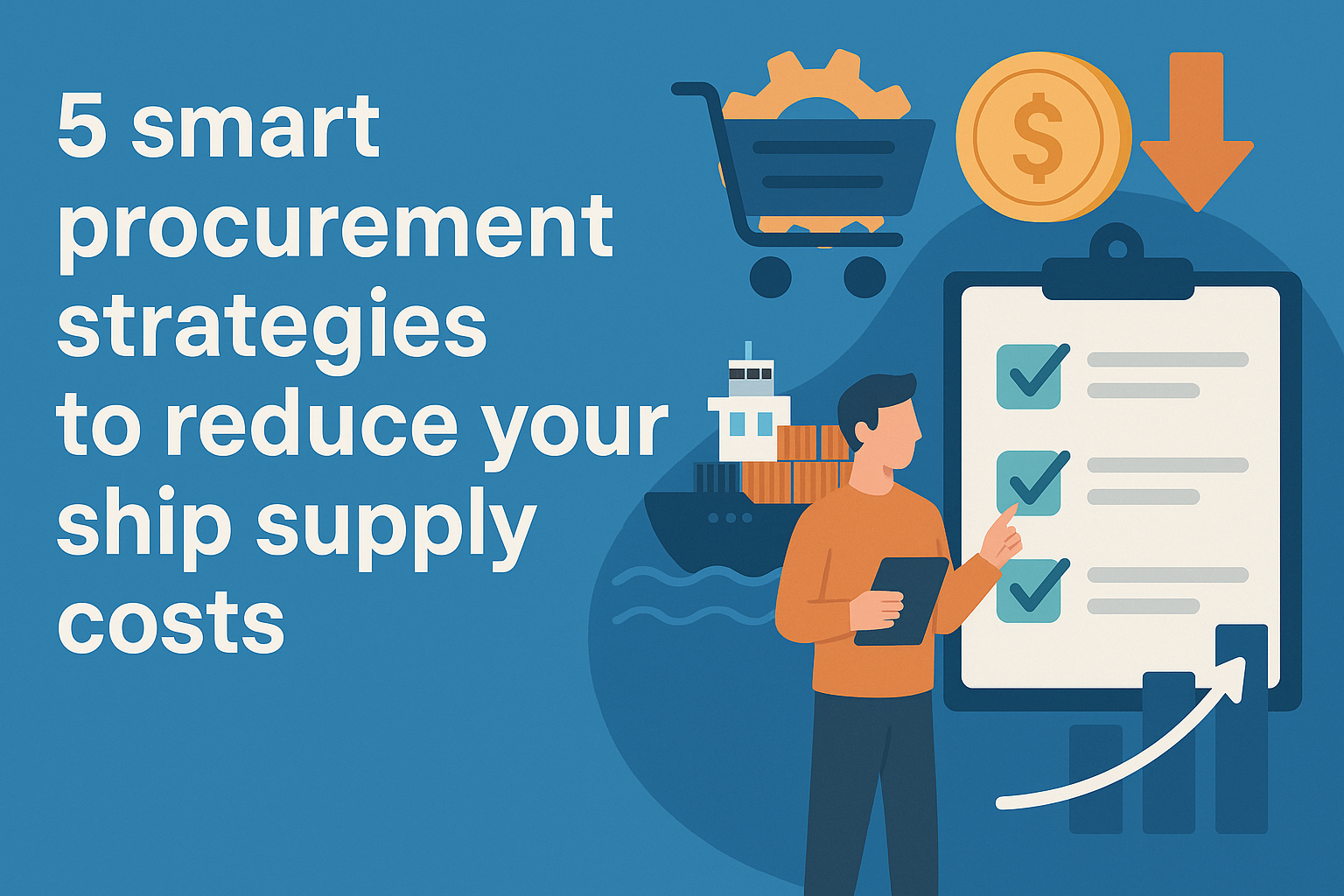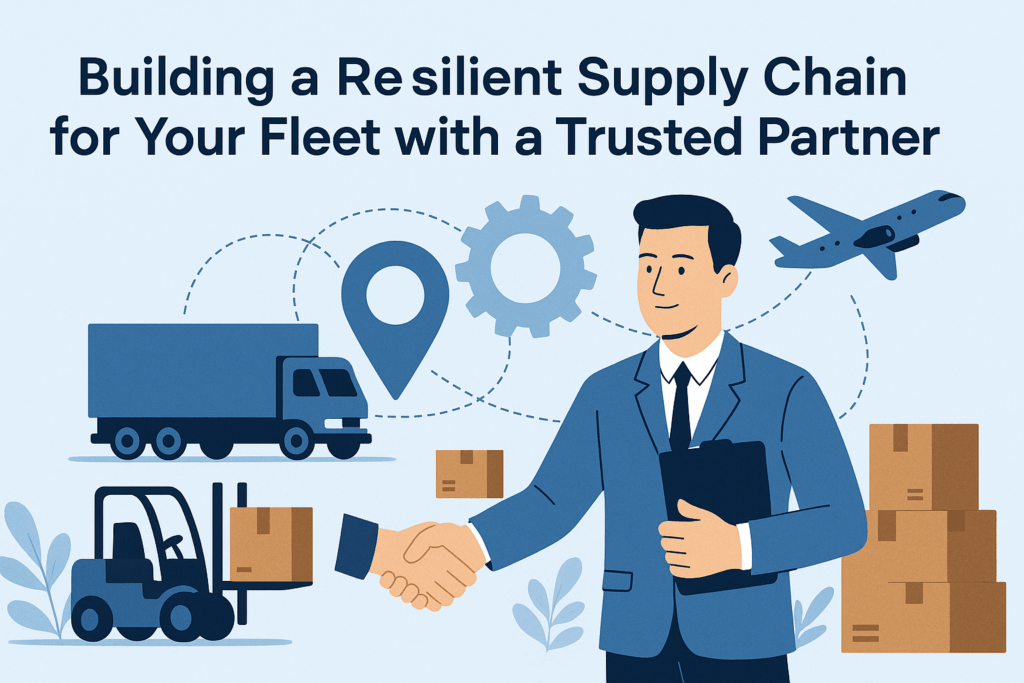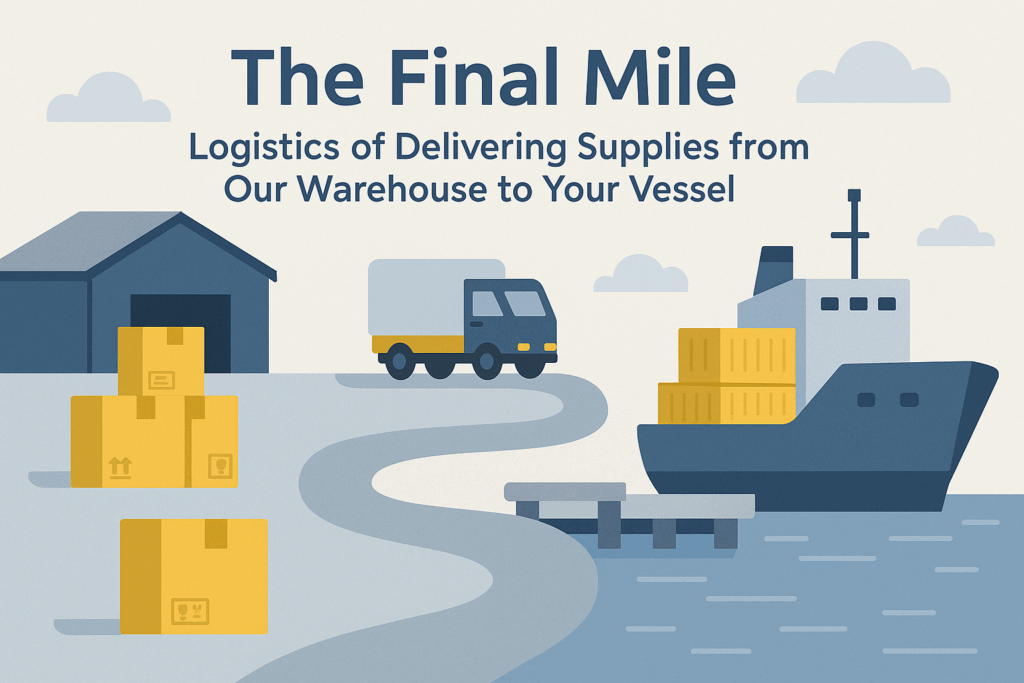The True Cost of Ship Supplies: Looking Beyond the Invoice Price
Before diving into cost-cutting strategies, it’s crucial to understand the Total Cost of Ownership (TCO) associated with ship supplies. The price tag on an invoice is just one part of the equation. Hidden costs can quickly inflate your actual expenditure, turning apparent bargains into expensive mistakes. Consider these factors:
- Quality vs. Price: Cheaper, lower-quality supplies might seem like a saving initially but can lead to premature failure, increased maintenance, more frequent replacement, and even safety hazards. For example, substandard deck supplies might corrode faster, or poor quality provisions can lead to spoilage and health issues.
- Spoilage and Waste: Particularly relevant for provisions, inadequate purchasing planning or low-quality goods can result in significant spoilage, meaning you pay for items that are never used.
- Administrative Overhead: Managing numerous suppliers, processing multiple small orders, and dealing with invoice discrepancies all consume valuable administrative time and resources.
- Delivery and Logistics Costs: Urgent, last-minute orders often incur premium delivery charges. Inefficient logistics planning can also add unnecessary transportation costs.
- Downtime and Delays: Receiving incorrect or substandard supplies can lead to operational delays while replacements are sourced, potentially costing far more than any initial saving on the items themselves.
A smart procurement strategy, therefore, focuses on optimizing TCO, not just minimizing the upfront price. It’s about getting the best value, ensuring reliability, and supporting smooth operations.
Unveiling the 5 Smart Procurement Strategies to Reduce Costs
Implementing a thoughtful approach to how you source and purchase your vessel’s necessities can yield significant financial benefits. Here are five proven strategies:
1. Strategic Supplier Partnerships & Consolidation
Transforming your relationship with suppliers from purely transactional to strategic partnerships can be a game-changer for cost reduction. This involves identifying reliable, high-performing ship chandlers and fostering long-term collaborations.
- Move Beyond Price-Only Decisions: While cost is a factor, evaluate suppliers on reliability, quality assurance (like HACCP or ISO certifications), range of services, delivery punctuality, and problem-solving capabilities. A dependable partner who understands your needs can prevent costly errors and delays.
- Supplier Consolidation: Reducing the number of suppliers you work with can lead to significant advantages:
- Volume Discounts: Concentrating your purchasing power with fewer suppliers often unlocks better pricing tiers and volume-based discounts.
- Reduced Administrative Burden: Fewer contracts to manage, fewer invoices to process, and streamlined communication save administrative time and costs.
- Improved Service Levels: Key suppliers are more likely to offer preferential treatment, better support, and tailored solutions to valued long-term partners.
- Consistent Quality: Working with a select group of vetted suppliers helps ensure more consistent quality across all your supply categories.
- Comprehensive Service Providers: Partnering with a chandler that offers a wide array of supplies, like Astro Ship Supply which provides provisions, deck & engine stores, cabin supplies, and bonded stores, can greatly simplify your procurement process.
Comparative Analysis: Strategic Partner vs. Multiple Ad-hoc Suppliers
| Aspect | Strategic Partner (e.g., Astro Ship Supply) | Multiple Ad-hoc Suppliers |
|---|---|---|
| Pricing | Potential for volume discounts, stable long-term pricing. | Variable, often higher unit costs for smaller orders. |
| Administrative Effort | Lower – streamlined ordering, invoicing, and communication. | Higher – managing multiple relationships, orders, and payments. |
| Service & Reliability | Higher – dedicated support, understanding of specific needs. | Inconsistent – service levels can vary greatly. |
| Quality Assurance | More consistent, easier to monitor and manage. | Variable, increased risk of substandard supplies. |
| Total Cost of Ownership | Generally lower due to efficiency and fewer issues. | Potentially higher due to hidden costs and inefficiencies. |
Building strong relationships with suppliers who offer comprehensive services and demonstrable reliability is a cornerstone of cost-effective maritime procurement.
2. Leveraging Data-Driven Procurement & Forecasting
In the digital age, data is a powerful tool for optimizing procurement. By analyzing past consumption patterns and future operational plans, you can make more informed purchasing decisions.
- Accurate Demand Forecasting: Utilize historical data (consumption rates, seasonal variations, route-specific needs) to predict future requirements more accurately. This minimizes both overstocking (tying up capital and risking spoilage) and understocking (leading to urgent, expensive orders).
- Inventory Optimization: Maintain optimal stock levels onboard. Too much inventory increases holding costs and the risk of obsolescence, while too little can disrupt operations. Data can help find the right balance.
- Identify Consumption Trends: Analyze data to spot trends in the usage of specific items. Are certain products being consumed faster than expected? Are there opportunities to switch to more durable or cost-effective alternatives?
- Technology for Procurement Analytics: Modern e-procurement platforms and inventory management systems can provide valuable insights, automate tracking, and help in forecasting. Even sophisticated spreadsheets can be a good starting point for smaller operators.
Use Case: “MV Efficient” Optimizes Provisioning with Data
The operators of “MV Efficient” previously relied on standardized order lists for provisions, leading to frequent overages of certain items and shortages of others, especially on routes with diverse crew preferences or varying voyage lengths. By implementing a simple data tracking system for actual consumption per voyage leg and integrating it with their voyage planner, they began to:
- Tailor provision orders more closely to the specific crew complement and voyage duration.
- Identify popular items versus those consistently left unused, adjusting future orders accordingly.
- Reduce spoilage of fresh produce by 20% by better aligning delivery schedules with actual consumption rates.
- Minimize last-minute “emergency” requisitions for forgotten or underestimated items.
This data-driven approach not only cut direct food costs but also reduced waste disposal efforts and improved crew satisfaction due to better availability of preferred items.
3. Mastering Negotiation & Contract Management
Effective negotiation and robust contract management are fundamental skills in procurement that can lead to direct cost savings and protect your interests.
- Negotiate Beyond Price: While price is key, don’t overlook other negotiable terms:
- Payment Terms: Longer payment cycles can improve your cash flow.
- Delivery Schedules & Costs: Negotiate consolidated deliveries or fixed delivery charges.
- Quality Guarantees & Warranties: Ensure clear terms for replacement or refunds for substandard goods.
- Volume Rebates: Secure rebates for achieving certain spending thresholds.
- Understand Market Rates: Research and benchmark prices for key commodities and supplies. This knowledge empowers you during negotiations. Resources like industry reports or even comparing quotes (discreetly) can provide insights.
- Clear and Comprehensive Contracts: Ensure contracts clearly define all terms, including specifications, quantities, pricing, delivery terms, dispute resolution mechanisms, and quality expectations. Vague contracts can lead to costly misunderstandings.
- Regular Contract Review: Don’t just sign and file. Regularly review supplier contracts to ensure they still meet your needs and reflect current market conditions. Re-negotiate terms when contracts are up for renewal or if significant changes occur in your operational requirements.
- Long-Tail Keyword Focus: Proactively “negotiating favorable terms with marine suppliers” involves preparation and a clear understanding of your leverage points.
Building a reputation as a fair but astute negotiator can lead to better long-term supplier relationships and sustained cost benefits.
4. Optimizing Order Specifications & Quality Tiers
Precisely specifying what you need—and importantly, what you don’t—can prevent overspending on unnecessarily high-spec items while ensuring fitness for purpose.
- Avoid “Gold-Plating”: Scrutinize requests for premium or over-specified items. Is the highest grade always necessary, or would a standard, good-quality alternative suffice without compromising safety or performance? For example, for certain cabin supplies, functional durability might be prioritized over luxury branding.
- Understand Different Quality Tiers: Work with your technical teams and crew to define acceptable quality standards for different categories of supplies. A critical engine component requires top-tier quality, but basic cleaning supplies might not.
- Standardize Where Possible: Standardizing certain commonly used items across your fleet can lead to volume discounts and simplify inventory management.
- Balance Cost with Lifecycle Value: Sometimes, a slightly more expensive item with greater durability or lower maintenance requirements can be more cost-effective in the long run (better TCO). This is often true for paints, ropes, or certain machinery spares.
- Regular Specification Reviews: Periodically review your standard order lists and specifications. Are they still relevant? Are there new, more cost-effective alternatives available in the market that meet your quality requirements?
Comparative Analysis: Premium Paint vs. Standard Paint for a Non-Critical Area
| Factor | Premium, High-Performance Paint | Standard, Good-Quality Paint |
|---|---|---|
| Upfront Cost | Higher | Lower |
| Durability (in non-critical, sheltered area) | Very High (e.g., 7-10 years) | Adequate (e.g., 4-6 years) |
| Re-application Frequency | Less Frequent | More Frequent |
| Labor Cost (over 10 years) | Lower (fewer applications) | Higher (more applications) |
| Suitability for Purpose | Potentially over-specified for the area. | Fit for purpose, meets aesthetic and basic protection needs. |
In this scenario, for a non-critical, sheltered area, the standard paint might offer a better TCO by balancing upfront cost with acceptable performance and lifecycle. The key is to make informed choices based on specific needs.
5. Embracing Volume Purchasing & Group Procurement
Leveraging economies of scale through intelligent bulk purchasing can significantly reduce per-unit costs for many types of ship supplies.
- Planned Bulk Orders: For non-perishable items with predictable consumption rates (e.g., cleaning supplies, stationery, certain spare parts, some dry provisions), plan consolidated bulk orders to take advantage of volume discounts.
- Centralized Procurement (for larger fleets): If you operate multiple vessels, centralizing procurement for common items can create substantial purchasing power.
- Group Purchasing Organizations (GPOs): Smaller shipping companies can explore joining GPOs. These organizations pool the purchasing volume of multiple members to negotiate better deals with suppliers than individual companies could achieve alone. You can often find relevant GPOs through maritime industry associations or specialist procurement consultancies like those mentioned by the Chartered Institute of Procurement & Supply (CIPS).
- Storage Considerations: Effective bulk purchasing requires adequate and appropriate onboard or shoreside storage. Factor in storage costs and logistics when evaluating bulk deals.
- Supplier Agreements for Call-Offs: Negotiate framework agreements with suppliers for a large annual volume, with the ability to “call off” smaller quantities as needed at the agreed bulk price. This gives you volume benefits without having to take delivery of everything at once.
Quotable List: Key Considerations for Bulk Supply Orders
- ☑️ Shelf-life of the product versus consumption rate.
- ☑️ Availability and cost of adequate storage space (onboard and ashore).
- ☑️ Potential for product obsolescence or changes in operational needs.
- ☑️ Impact on cash flow (tying up capital in inventory).
- ☑️ Supplier’s capacity to handle and deliver bulk orders reliably.
- ☑️ Actual net savings after factoring in all associated costs.
The Astro Ship Supply Edge: Smart Solutions for Cost-Effective Procurement
At Astro Ship Supply, we believe that smart procurement is key to your operational success. We’re more than just a supplier; we’re your partner in finding cost-effective solutions without compromising the quality and reliability your vessel demands. Our extensive range of services, from premium provisions to essential deck & engine supplies, allows for consolidated purchasing, streamlining your processes and unlocking potential volume benefits. Our experienced team understands the intricacies of maritime supply and can work with you to analyze your needs, identify cost-saving opportunities, and ensure you receive the best possible value. We are committed to “Smart solutions” and “Excellence in Every Delivery,” supporting your efforts to manage expenses wisely.
Ready to explore how these procurement strategies can trim your ship supply costs and enhance your bottom line? Request a quote from Astro Ship Supply today and let our experts help you chart a course to greater efficiency and savings.
Case Snippet: “Gulf Coast Freighters” Trims 12% from Supply Budget
Gulf Coast Freighters (GCF), a regional operator of five cargo vessels, was facing mounting pressure from rising operational costs. Their procurement process was largely decentralized, with individual vessels often placing urgent orders with various local suppliers, leading to inconsistent pricing and high administrative overhead.
GCF decided to overhaul its procurement strategy. They implemented two key changes based on the principles discussed:
- Supplier Consolidation: After a thorough review, GCF selected a primary Houston-based ship chandler (akin to Astro Ship Supply) for the majority of their provisions, deck, and cabin supplies for vessels calling at Gulf ports. This allowed them to negotiate a fleet-wide agreement with better pricing and standardized service levels.
- Improved Forecasting & Order Planning: They invested in a basic shared system for tracking consumption and planning orders further in advance, reducing the frequency of costly “emergency” requisitions.
The Results within one year:
- Reduced Annual Supply Expenditure: GCF achieved a documented 12% reduction in their overall ship supply costs.
- Lowered Administrative Overhead: Time spent on processing purchase orders and invoices decreased by an estimated 25%.
- Improved Budget Predictability: Supply costs became more stable and easier to forecast.
- Enhanced Supplier Relationship: Having a primary, reliable partner improved communication and responsiveness for their supply needs.
This real-world type of scenario demonstrates that strategic changes in procurement, even seemingly simple ones like consolidation and better planning, can yield substantial and measurable financial improvements.
Conclusion: Procurement as a Strategic Lever for Profitability
Reducing ship supply costs is not about cutting corners; it’s about making smarter, more strategic decisions. By embracing these five procurement strategies—fostering strong supplier partnerships, leveraging data, honing negotiation skills, optimizing specifications, and utilizing volume purchasing—ship operators can transform procurement from a mere operational necessity into a powerful lever for enhancing profitability and ensuring long-term sustainability in a competitive maritime market.
Frequently Asked Questions (FAQ)
How can small shipping companies benefit from strategic procurement if they have limited purchasing volume?
Small companies can still achieve significant benefits:
- Supplier Consolidation: Even with smaller volumes, consolidating most purchases with one or two reliable local suppliers can build loyalty and potentially lead to better service and slightly better terms than spreading tiny orders across many vendors.
- Focus on TCO: Prioritize quality and reliability to avoid costly downtime or spoilage, which can disproportionately affect smaller operators. Astro Ship Supply, for instance, serves vessels of all sizes with a focus on quality. You can learn more about their approach on their about us page.
- Efficient Processes: Streamline ordering and payment processes to save administrative time, which is a valuable resource in smaller teams.
- Careful Specification: Avoid over-specifying to ensure money isn’t wasted on features or quality levels that aren’t strictly necessary.
- Explore Cooperatives: Investigate local or regional group purchasing opportunities if available for certain common items.
What are common hidden costs in ship supply agreements that I should watch out for?
Be vigilant for these potential hidden costs:
- Excessive Delivery Charges: Especially for off-hours, urgent, or small orders. Clarify standard delivery fees upfront.
- Minimum Order Quantities/Values: Fees or higher prices if your order falls below a certain threshold.
- Restocking Fees: Charges for returning incorrect or surplus items, even if it wasn’t your error.
- Fuel Surcharges: May be added to delivery costs, fluctuating with fuel prices.
- Currency Exchange Rate Fluctuations: If dealing with international suppliers, understand who bears the risk of adverse currency movements.
- Short Shelf-Life Products: Receiving provisions with very short expiry dates can lead to waste, a hidden cost.
- Vague Quality Specifications: Can lead to receiving lower-grade items than expected, which then require earlier replacement.
Always aim for transparency and clarity in all terms before finalizing an agreement. Don’t hesitate to request a detailed quote that itemizes all potential charges.
Is it always cheaper to buy in bulk for ship supplies?
Not necessarily. While bulk purchasing often offers lower per-unit prices, you must consider the Total Cost of Ownership:
- Storage Costs: Do you have adequate, safe, and climate-controlled storage? If not, the cost of arranging it might negate savings.
- Capital Tied Up: Large inventories mean capital is tied up that could be used elsewhere.
- Risk of Spoilage/Obsolescence: For perishable goods or items that might become outdated (e.g., due to regulatory changes or technological advancements), bulk buying can lead to waste.
- Insurance Costs: Higher inventory values might increase insurance premiums.
- Handling Costs: Managing larger inventories can require more labor.
Bulk buying is most effective for non-perishable items with high, predictable consumption rates and where storage is not an issue. Always perform a cost-benefit analysis.
How does supplier relationship management (SRM) impact procurement costs?
Effective SRM is crucial for cost optimization in the long run:
- Better Negotiation Outcomes: Strong relationships foster trust and mutual understanding, often leading to more favorable terms and a willingness from suppliers to collaborate on cost-saving initiatives.
- Improved Reliability: Valued customers often receive priority service, reducing the risk of costly delays or stock-outs.
- Access to Innovation: Suppliers are more likely to share new product information or suggest more cost-effective alternatives to trusted partners.
- Reduced Transaction Costs: Smooth communication and established processes with long-term suppliers can reduce the administrative effort per transaction.
- Proactive Problem Solving: When issues arise, a good relationship facilitates quicker and more amicable resolutions, preventing minor problems from escalating into expensive ones. For insights into robust supply chain practices, consider resources from organizations like the Supply Chain Dive or similar industry publications.
What key technologies can help reduce ship supply costs?
Several technologies can contribute to cost reduction:
- E-procurement Platforms: Streamline the purchasing process, from requisition to payment. They can offer catalog management, automated ordering, and spend analytics.
- Inventory Management Systems (IMS): Help optimize stock levels, track consumption, manage expiry dates, and reduce waste.
- Data Analytics Tools: Analyze historical purchasing and consumption data to improve forecasting, identify savings opportunities, and monitor supplier performance.
- Supplier Portals: Facilitate better communication and collaboration with suppliers, including order tracking and invoice management.
- Budgeting and Spend Management Software: Provides visibility into spending patterns and helps control costs against budgets.
The key is to choose technologies that are appropriate for your company’s size and complexity and to ensure they are properly integrated into your procurement processes.






